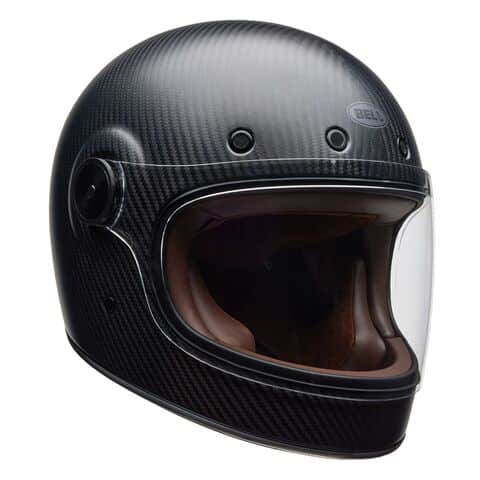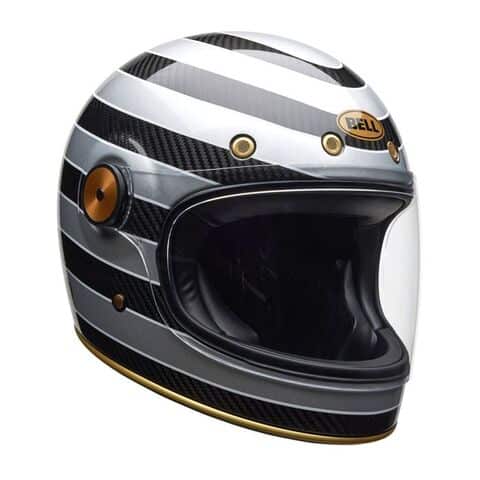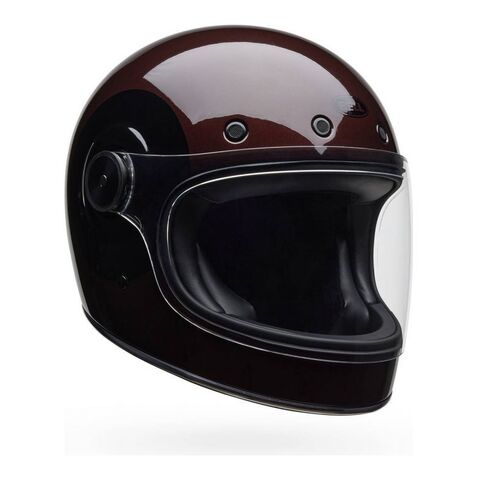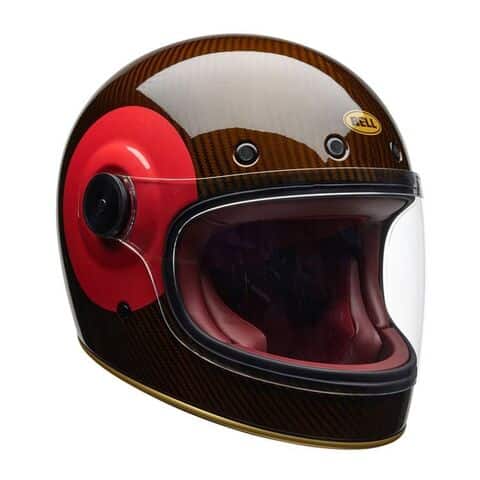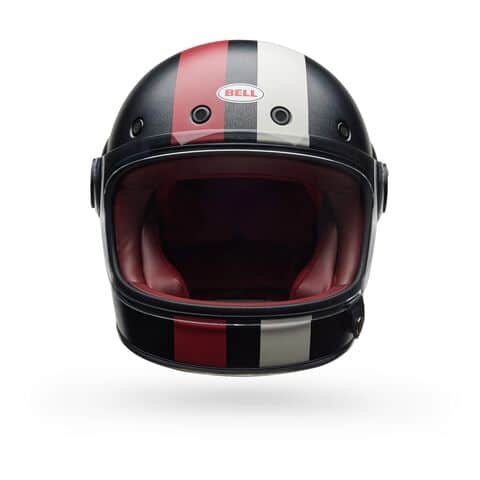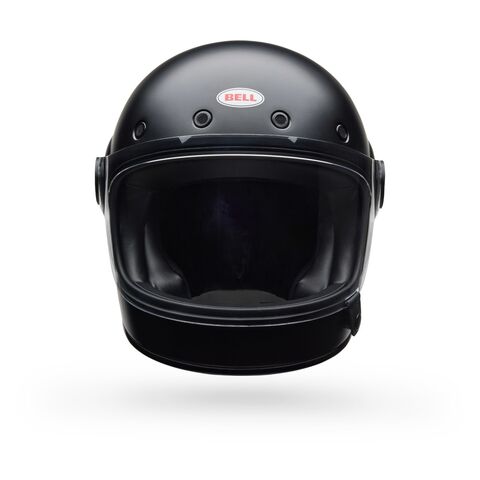Our Bell Bullitt GT Review is an exploration of how a legendary helmet design adapts to today’s safety and style demands.
We examined the evolution from the original Bell Star, measuring how contemporary materials and ECE 22.06 certification shape the experience for real-world riders.
We focused on the intersection of retro aesthetics and contemporary engineering, highlighting what sets this motorcycle helmet apart in a crowded market.
Is this Bell Bullitt GT Review the resource you need to decide if classic looks and current protection align with your riding priorities?
Our Bell Bullitt GT Final Verdict
What We Like
Shell Construction Delivers A Classic Look and Real Protection
The Shell construction gives you a classic silhouette with either composite fiberglass or carbon fiber, both ECE 22.06 and DOT certified. Shell construction feels sturdy, but the wall flexes a bit if you squeeze the sides.
Aerodynamics Provides Smooth Riding but Lacks Sporty Stability
Aerodynamics keeps the ride smooth at city and moderate speeds, thanks to the rounded shell and subtle exhaust cut-out. Aerodynamics doesn’t eliminate buffeting or create negative lift, so you’ll feel some movement at highway speeds, especially with no chin curtain.
Sizing Offers Custom Comfort with Some Sizing Quirks
Sizing gives you a round-oval shape that’s true for most, with an improved feel over the original Bullitt. Sizing can still be tricky for some riders, including me, had to size up, and cheek pads come in 35mm or 45mm but you can’t always swap for thinner or thicker.
Interior and Padding Brings Plush Comfort and Easy Maintenance
Interior and padding uses antimicrobial PU leather and suede for a plush, removable liner that’s easy to wash.
The interior includes 50mm speaker pockets for comms, but the leather trim around the face shield is a thin split, not full-grain, which feels less premium.
Ventilation Balances Vintage Looks and Practical Cooling
The ventilation now lets you close the four forehead vents with a slider, which is a big upgrade for rainy days or cold mornings.
The ventilation mechanism still can’t match modern lids for airflow—on hot days or at low speeds, it gets warm behind the face shield, and there’s no chin vent to help.
Visor Mechanism Delivers Wide View and Quick Changes
The visor mechanism gives you a massive field of view and a tool-free quick-release mechanism. Visor mechanism can mist up in cold weather because there’s no Pinlock, and some users report the visor shakes or flips up at speed if you turn your head.
Noise Levels Trade Silence for Open-Face Vibes
Noise levels are higher than most contemporary full-face helmets because of the big chin opening and large viewport.
Noise levels can be tamed with earplugs, but you’ll notice wind noise and buffeting, especially above 40 mph.
Safety Certifications Provide Confidence for Global Riders
Safety certifications include ECE 22.06 and DOT, so you can ride legally in Europe and North America.
Safety certifications are a big step up from the original Bullitt, giving you peace of mind with the classic look.
Weight Keeps Things Manageable for Daily Rides
Weight comes in at 3 lbs 5 oz for fiberglass and 3 lbs 1 oz for carbon in size large, which is light for a lid that meets ECE 22.06.
Weight is still a bit more than some racing lids, but the even distribution and compact shell make it easy to wear all day.
Bluetooth Options Make Tech Integration Simple
Bluetooth options are easy to install with large 52mm speaker pockets and enough space for most intercoms.
Installing a Bluetooth kit can be fiddly if you care about the classic look since cables have to run over or under the bonded neck skirt.
Color Options Let You Show Off Your Personality
Color options include ten solid and graphic choices, from gloss black to wild carbon graphics, each with matching black, brown, or red leather interiors.
The color options for carbon are pricey, but the finish on every model is top-notch and gets compliments at every bike night.
Potential Drawbacks to Consider
The Bullitt GT brings style and comfort, but there are some potential drawbacks. The drawbacks are you get some wind noise, some visor quirks, and a premium price tag—especially for carbon.
The Bullitt GT doesn’t have a Pinlock option, and sizing can be tricky if you’re between sizes.
Prices change as special offers are available from Revzilla.com, so check out the best prices before buying elsewhere.
Revzilla won’t be beaten on price with their price match guarantee. If the item doesn’t feel right, or you’re just not happy with it, you can return any new, unused, and unaltered item within 90 days of delivery of your item.
Like and share this article—it helps Google know you like the page!
Specifications
- 42% fiberglass or 40% carbon fiber shell construction
- Three shell sizes across XS to XXL
- ECE 22.06 and DOT certified
- Weight: 3 lbs 5 oz (1,500g) for large fiberglass, 3 lbs 1 oz (1,400g) for large carbon
- Multi-density EPS liner for impact absorption
- Five closable metal mesh forehead vents
- Large rear exhaust port for airflow
- Tool-less ClickRelease face shield mechanism
- Rubber face shield gasket for improved sealing
- Magnetic Magnefusion Shield Closure Mechinism
- Enlarged eye port for a wide field of vision
- Removable, washable, anti-bacterial micro-suede liner
- 3D cut cheek pads with integrated speaker pockets
- Optional cheek pad sizes for a custom feel
- Padded chin strap with stainless steel D-Ring and leather pull tab
- Available in ten solid and graphic color options
- Leather liner in black, brown, or red
- Accessory shields (flat, bubble, tinted) available
- Can be worn as an open-face with supplied side covers
- Double-D ring fastener
- Industry-leading five-year warranty
Key Takeaways
Here are a few takaways to consider:
- Delivers classic aesthetics always.
- Offers ECE 22.06 protection.
- Features closable forehead vents.
- Provides wide visor visibility.
- Supports glasses inside comfortably.
- Weighs less than its rivals.
- Allows Bluetooth speaker installation.
- Includes plush removable liner.
- Creates noticeable wind noise.
- Lacks Pinlock-ready shield.
- Costs more for carbon.
- Supports open-face riding.
- Earns strong safety ratings.
Comparison to Similar Models
| Model (Hyperlinked) | Weight (lbs) | Safety Certifications | Bluetooth | Noise Levels |
|---|---|---|---|---|
| Bell Bullitt GT | ~3.3 (varies by size; some sources list up to ~3.7 lbs, but most medium sizes are ~3.3 lbs) | DOT, ECE 22.06 | Compatible (speaker pockets) | Moderate/High (open face, some wind noise; improved gasket helps, but still noisy compared to full-face touring helmets) |
| Bell Race Star Flex DLX | ~3.3 | DOT, ECE, FIM (Pro Star version) | Compatible (no built-in Bluetooth) | Low (aerodynamic, quieter than most for a race helmet; user experiences vary, but generally good noise reduction) |
| Bell Qualifier DLX | ~3.3–3.5 (varies by size) | DOT, ECE 22.05 (DLX MIPS) | Compatible (recessed speaker pockets) | Moderate/High (noted for wind noise, especially at speed) |
| Bell Eliminator | ~3.0–3.3 (varies by version/size) | DOT, ECE 22.05 (SHARP 5 Star for ECE version) | Compatible (recessed speaker pockets) | Moderate/High (shorty design, more wind noise) |
| Bell Lithium | ~3.0 (standard), Lithium MIPS ~3.7 lbs | DOT, ECE 22.06 | Compatible (comms ready) | Moderate (not excessive, but not the quietest; some wind noise at speed) |
Summary Notes:
- Bell Bullitt GT: Retro open face, moderate weight, improved gasket for noise, but still relatively noisy due to open design.
- Bell Race Star Flex DLX: Premium race helmet, aerodynamic, excellent noise reduction, FIM homologation available.
- Bell Qualifier DLX: Affordable, comms ready, good ventilation, quite noisy[review URL].
- Bell Eliminator: Retro shorty, lighter weight, SHARP 5 Star safety (ECE), more wind noise due to open profile.
- Bell Lithium: Lightweight (standard), heavier (MIPS), ECE 22.06 certified, comms ready, moderate noise.
All models are compatible with aftermarket Bluetooth/intercom systems, but none include built-in Bluetooth. Noise levels are generally moderate to high due to design and ventilation features, except for the Race Star Flex DLX, which stands out for its quietness.
Bell Bullitt GT Shell Materials
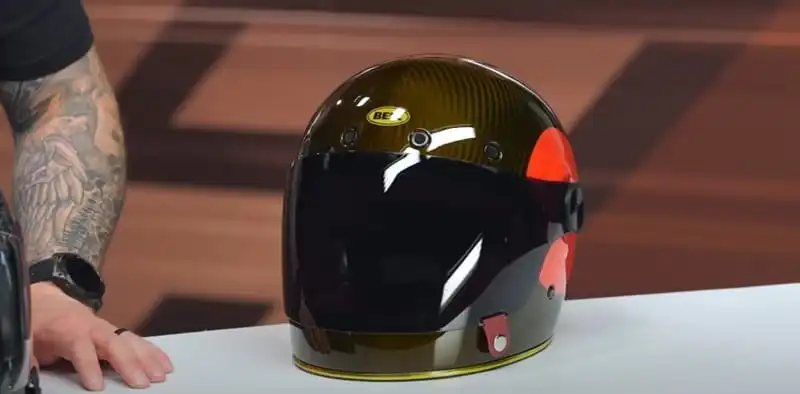
The standard version of the Bullitt GT uses 42% fiberglass materials in its shell, while the carbon fiber variant employs 40% carbon fiber construction. This dual-material approach gives you flexibility based on your priorities and budget.
Aerodynamics
The Bullitt GT isn’t designed for aerodynamic performance or speed-focused riding. It features a smooth aerodynamic shape that allows air to flow around it reasonably well, but its limitations become apparent quickly at highway speeds.
The subtle exhaust cut-out at the back represents the only nod to modernity in this retro-styled design. I’ve experienced no problems with the aerodynamics during normal riding, but the relaxed feel and open design create stability issues at speed.
Bell Bullitt GT Size
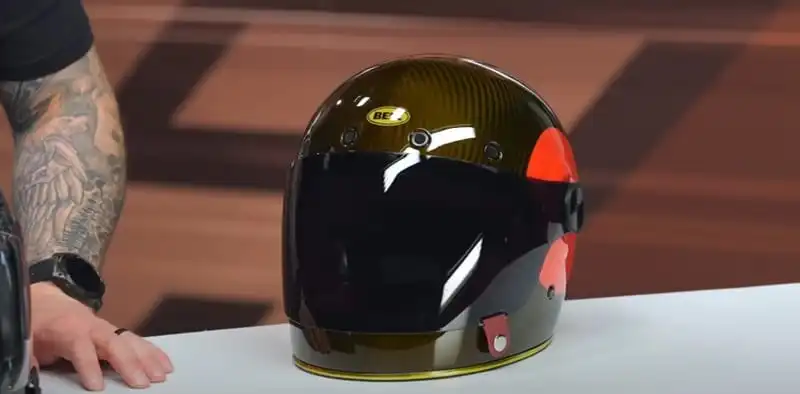
It fits true to size for most riders, although one of our team noted noted that a medium fit him spot on across nearly every manufacturer.
The fit characteristics show a little snugness around the crown but provide nice fitment down the sides, which creates that classic Bell profile without the bobblehead look.
There are three shell sizes available to maintain proportions: small covers XS and SM helmets, medium handles MD and LG, while large accommodates XL and 2XL sizes. This shell sizing approach keeps the vintage aesthetic intact across all head sizes.
The original Bullitt more naturally fits a rounder-shaped head, but the GT’s updated headform attempts to broaden compatibility.
Bell Bullitt GT Interior
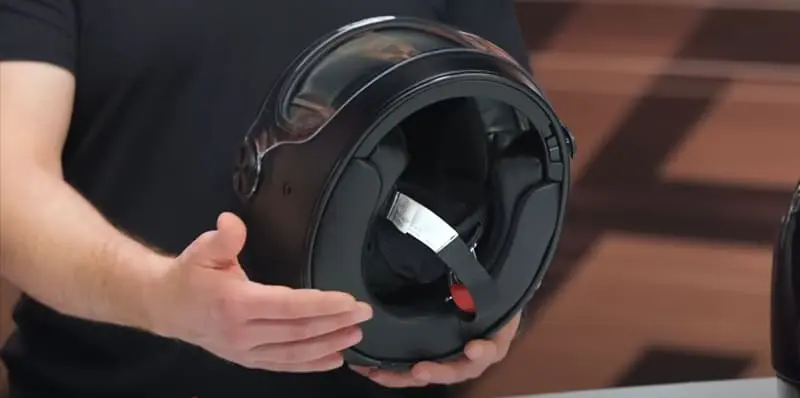
The interior materials feature antimicrobial properties that help resist odor and bacterial growth during extended wear.
I’ve found this helpful during summer riding when sweat becomes a concern. The liner comes fully removable and easily detaches for hand washing.
Bell uses a brow mount mechanism at the front of the headliner that eliminates pressure points caused by the traditional snap mechanism.
The snaps for the liner sit at the back and bottom of the neck where you won’t feel them during rides. This design choice addresses a common complaint about snap-based mounting mechanisms creating hot spots on the forehead.
Cheek Pads
The cheek pads can be swapped out to fine-tune your fit, offering different thicknesses of 35mm and 45mm.
Your helmet size determines which thickness of cheek pads comes as standard, and you’re limited by what your size includes – if you get 35mm pads standard, you can’t go thinner, and if you get 45mm pads, you can’t go thicker.
I’ve experimented with different cheek pad thicknesses and found the adjustment range helpful for customizing fit.
The three-snap mechanism on each cheek pad makes swapping straightforward, though you’ll need to purchase replacement pads separately at around $22.99.
Ventilation
The ventilation features four forehead vents that represent a major upgrade over the previous model – these vents are now fully closable.
The closing ventilation mechanism uses an easy-to-operate slider or trigger located under the chin bar that I can operate while riding.
You can hear the vents closing as plastic pieces slide into position behind the metal mesh screens.
A single exhaust vent is included at the back that helps pull hot air out using the Venturi effect.
However, they removed the chin vent that existed on the older version after CFD analysis suggested it wasn’t effective. The large opening ventilation design allows substantial air to flow up and under the chin bar area.
I’ve noticed the exhaust vent introduces some wind noise around 30-40mph, though it disappears at higher speeds.
The mesh over the forehead intakes prevents bugs from entering, which I appreciate during summer rides through wooded areas.
Bell Bullitt GT Visor Functionality and Design
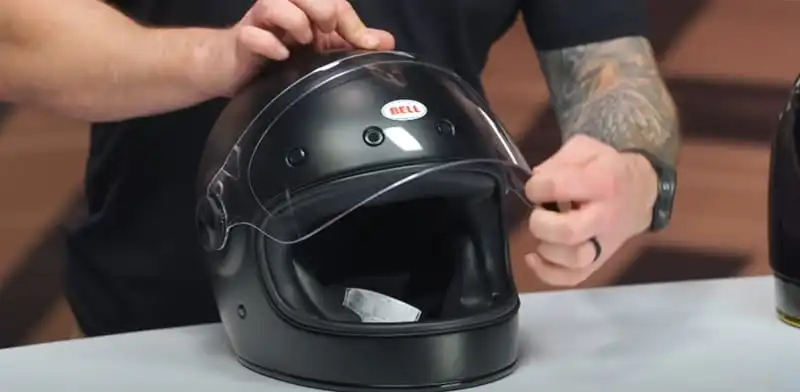
The visor can be cracked just open for more airflow, though it tends to close down from this cracked position at anything above slow urban speeds.
I’ve found that tucking the leather tab under the visor and closing it down helps maintain more of a cracked position for increased airflow.
The first positive stage of the visor opens about 7cm and stays open up to motorway speeds, then from there it’s right up to the positively locked fully open position which stays open at any speed.
The visor mechanism feels very smooth in operation, and the visor seats itself without locking down.
Bell uses a magnetic closure tab to hold the visor down when fully closed – it’s a neat feature that works well and prevents the pull tab from flapping about.
The company made a secondary wiper blade mechanism to help seal the visor while keeping the aesthetic of the hinge plates.
The GT features a new quick-release visor, no-tools visor mechanism that represents a major upgrade over the original model.
Just press the central button on the side covers then slide them back and the visor is easily removed. Pop the visor back on and they snap securely back in place – it’s brilliant for cleaning and for swapping visors.
You can wear it as an open face by removing the visor and installing the supplied plastic side covers.
Goggles will fit in the aperture, though I found that with mine at least, I had to pitch the helmet up just a fraction due to the position and angle of the forehead lining. The strap isn’t retained though, so make sure you have one with silicone grips on the inside.
Sun Visor
The Bullitt GT doesn’t include an internal drop-down sun visor. This means you’ll need to rely on tinted visors or sunglasses for sun protection.
There are various tinted visor options including iridium dark silver and smoke variants, with original Bullitt visors listed at $39.95 USD for colored, clear, and smoke flat visors.
Bell Bullitt GT Noise Levels
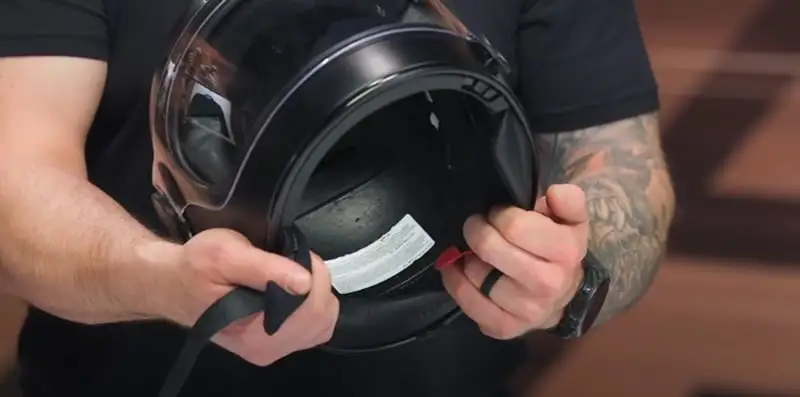
It is relatively noisy and noisier than some of its competition due to fundamental design choices that favor the vintage aesthetic.
They made improvements to soundproofing, but these changes are minimal because of the large front opening design that defines the Bullitt’s character.
The large opening creates a compromise – you get increased visibility but sacrifice quiet operation.
I’ve noticed that air comes in under the helmet at a speed where there’s no chin guard, and this airflow generates substantial noise that becomes annoying after 100 miles or so of highway riding.
Testing data shows the Bullitt DLX averaged 102 dB on sound meters, which places it in line with other classic-looking helmets like the AGV X3000 and Shoei Glamster.
While this isn’t terrible for a vintage-styled lid, it’s still louder than sport-touring lids that prioritize acoustic comfort.
The exhaust vent at the back introduces some wind noise around 30-40mph, though this disappears at higher speeds.
I’ve found that the visor mechanism can also contribute to noise levels. At high speeds, it can sound as if it is whispering to you because of the visor.
One way to solve the rattle issues is to add foam sealing around the lens opening, which eliminates annoying rattles at highway speed but doesn’t eliminate wind noise altogether.
If you’re planning long-distance tours, earplugs become a necessity rather than an option.
Bell Bullitt GT Safety Certifications

The Bullitt GT is certified as a full-face helmet under ECE 22.06, which represents the latest and most rigorous European safety standard.
This certification addresses previous concerns about safety standards that existed with earlier classic helmets in the market.
The GT meets DOT certification standards, creating what the company describes as an “extra bump of safety feature” by achieving both certifications in one shell design.
I like that they didn’t compromise on safety to achieve the vintage look – the GT version now meets these current, stricter safety standards while maintaining the classic Bell aesthetic.
Bell Bullitt GT Weight
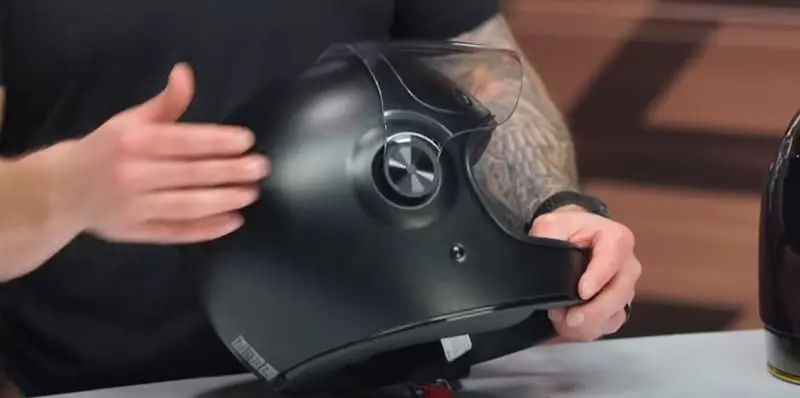
It weighs 3.20 pounds (51.2 ounces) for a medium size in the standard fiberglass version, with Bell listing it at 1,450g +/- 50g.
A large size actually measured 3.16 pounds (50.6 ounces) on our scales, making it lighter than the claimed 3.31 pounds (53.0 ounces).
This puts the Bullitt GT among the lighter full-face motorcycle helmets I’ve tested, particularly for one meeting the tougher ECE 22.06 standard.
The carbon version drops weight further to 2.98 pounds (47.6 ounces) for a medium, with the large carbon shell coming in at 3.09 pounds (49.4 ounces).
We measured our medium carbon version at 2.98 pounds (47.7 ounces), confirming Bell’s specifications are accurate.
| Version | Size | Weight (lbs) | Weight (oz) |
|---|---|---|---|
| Fiberglass | Medium | 3.20 | 51.2 |
| Fiberglass | Large | 3.16 | 50.6 |
| Carbon | Medium | 2.98 | 47.6 |
| Carbon | Large | 3.09 | 49.4 |
I’ve worn this helmet for hours without neck strain, and the weight distribution feels balanced. The shell construction keeps mass low while maintaining the classic Bell profile that riders love.
Compared to the original Bullitt at 3.09 pounds (49.4 ounces), the GT version maintains a similar weight while adding contemporary safety compliance.
The Bullitt GT proves you don’t need to accept heavy weight for classic styling. At $435 for the standard version and $615 for carbon, the weight savings justify the price difference for riders who value comfort during long rides. This vintage look doesn’t come with the neck fatigue penalties of heavier classic helmets.
Bell Bullitt GT Bluetooth Options
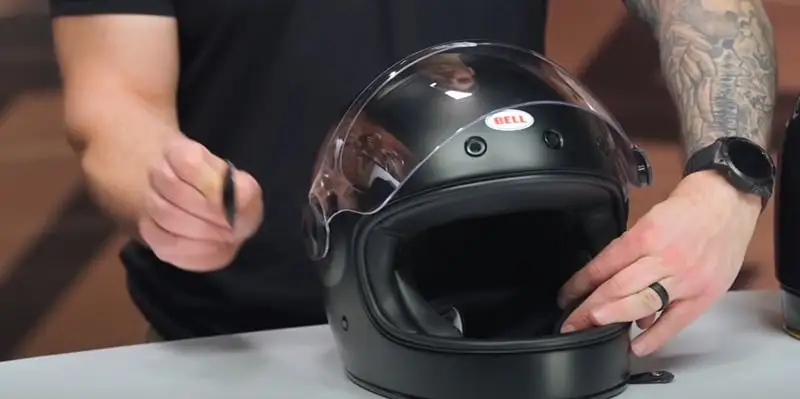
The Bluetooth mechanism is designed with integrated speaker pockets that accommodate most communication systems on the market today.
The pockets were engineered at 50mm in diameter and 12mm deep, making them larger than typically needed for current systems by preemptively making them as big as possible for future compatibility.
The helmet features large speaker pockets that provide plenty of space for Bluetooth installation. I’ve found these pockets accommodate popular Bluetooth units from Sena, Cardo, and other manufacturers without modification.
They clearly anticipated the growing demand for Bluetooth comms in classic helmets and built the Bullitt GT to handle them properly.
Bluetooth installation is straightforward with plenty of space on the side of the helmet to mount the main unit.
The bonded-in neck skirt means the cable will likely need to run over it or tucked in just in front, but this doesn’t create any comfort issues during riding.
I’ve tested several Bluetooth kits in the speaker pockets and found them spacious enough for the most popular brands.
The only thing is, I wish they would make a drop-in Bluetooth kit. Looks like the helmet has a space on each side for speakers but I’m not seeing anything online specific to these helmets.
Bell Bullitt GT Color and Graphic Options
The Bullitt GT color options are built around ten solid color and graphic choices that span both fiberglass and carbon versions, giving you a huge range of style possibilities for this classic-looking helmet.
The Bullitt GT delivers what I consider a superb finish across all colorways, with some designs being totally breathtaking in their execution.
The standard fiberglass version starts at $399.95 for plain gloss black, blue, green, and matt black finishes.
Graphic versions like the ‘Wander’ model cost $429.95 and showcase their attention to detail – I’ve examined the stripe application on this model and found it seamless, with the off-white and solid black sitting beautifully under a deep gloss topcoat.
Carbon versions command $649.95 for plain finishes and $699.95 for graphic options. Each helmet comes finished with either a black, brown, or red leather liner that complements the exterior styling.
The carbon weave adds a contemporary touch to the classic Bell aesthetic while maintaining the vintage appeal that riders love.
| Version | Finish Type | Price (USD) | Lining Options |
|---|---|---|---|
| Fiberglass | Plain Colors | $399.95 | Black, Brown, Red Leather |
| Fiberglass | Graphics | $429.95 | Black, Brown, Red Leather |
| Carbon | Plain | $649.95 | Black, Brown, Red Leather |
| Carbon | Graphics | $699.95 | Black, Brown, Red Leather |
An array of flat and bubble visors are available with 15 styles to choose from, creating a total of 150 variations when you combine helmet colors with shield options.
I’ve tested several shield combinations and found the variety lets you customize the look from classic racing to modern street style.
The visor options include clear, tinted, and iridium finishes that change the entire character of the helmet.
A clear shield gives you that classic racing feel, while a dark-tinted visor creates a more aggressive street appearance. The bubble shields add vintage flair that takes you back to the golden age of motorcycle racing gear.
Bell Bullitt GT FAQ
Is the Bullitt GT comfortable for long rides?
I’ve found it is comfortable for shorter urban rides, but it’s not suitable for touring due to noise and wind buffeting. The helmet works well for gentle cruising and city riding, but the large front opening creates comfort issues during extended highway use.
How noisy is the Bullitt GT?
It is relatively noisy due to its large front opening design, with wind noise becoming the most frequently cited complaint among riders. I’d recommend earplugs for any ride over 100 miles, as the noise becomes annoying at highway speeds.
Can I wear glasses with the Bullitt GT?
The helmet works well with glasses, including prescription glasses, though very thick frames might cause issues. I’ve tested it with various glasses and found the eye port provides enough space for comfortable wear.
Are the new Bullitt GT visors compatible with the original Bullitt?
The Bullitt GT uses different visors than the previous model, so you can’t swap them between versions. They redesigned the visor mechanism for tool-free removal, which changed the mounting mechinism.
Can I install Bluetooth?
The helmet features large 50mm speaker pockets and plenty of space on the sides for intercom units, making Bluetooth installation straightforward. They designed these pockets larger than needed for current Bluetooth kits to accommodate future technology.
Is the Bullitt GT good for touring?
It’s not suitable for touring due to noise, ventilation, and aerodynamic limitations at speed. The “GT” designation refers to updated features rather than touring capability – it’s better suited for shorter rides and urban environments.
How does the ventilation perform?
The four closable forehead vents provide some cooling, but ventilation remains limited at low speeds and can get quite warm behind the visor on hot days. The exhaust vent helps pull hot air out, but overall airflow isn’t as powerful as sport-touring helmets.
What’s the weight difference between fiberglass and carbon versions?
The fiberglass version weighs 3.16 pounds (50.6 ounces) for a large, while the carbon version drops to 3.09 pounds (49.4 ounces). Both versions feel lightweight for retro helmets, especially considering the ECE 22.06 safety certification.
What color options are available for the Bullitt GT?
Ten solid color and graphic options are available across fiberglass and carbon versions, with prices ranging from $399.95 for plain colors to $699.95 for carbon graphics. The finish quality is superb across all colorways, with leather liner options in black, brown, or red.
Bullitt GT Conclusion
The new Bullitt GT is a polarizing helmet that divides motorcycle communities between those who value looks over substance and riders who prioritize performance metrics above all else.
I’ve found that many acknowledge objectively better and more versatile helmets exist for less money, yet the Bullitt GT remains a bestseller due to its iconic classic aesthetic and rich legacy in motorcycle culture.
Purchasing the Bullitt GT represents a decision made “from the heart, rather than the head”. The helmet costs $399.95 for standard colors and reaches $699.95 for carbon graphics, placing it at a premium price point where performance-focused alternatives offer more features for less money.
But numbers don’t tell the whole story when you’re talking about a lid that honors Bell’s classic racing heritage.
The GT version includes several welcome updates based on user feedback that address previous complaints.
The closable forehead vents, improved visor mechanism with tool-free removal, and updated ECE 22.06 safety certification show Bell listened to the community.
At 3.16 pounds (50.6 ounces) for a large fiberglass version, it’s reasonably light for a classic helmet meeting modern safety standards.
This vintage-looking helmet succeeds at what it sets out to do – honor Bell’s star legacy while delivering a classic aesthetic that turns heads at bike nights. J
Just don’t expect it to compete with modern sport touring helmets on performance metrics, and you’ll love what this retro lid brings to your riding experience.
The Bullitt GT proves that sometimes the heart wins over the head, and there’s nothing wrong with choosing a helmet that makes you feel good about your ride.
More Information
Which Rider Is It For?
The helmet targets riders who value a distinctive look and vintage appeal above all other considerations.
I’ve seen this lid on cafe racers, classic cruisers, and modern bikes where owners want to channel that rich racing legacy that Bell represents. You’re buying into motorcycle culture rather than chasing lap times or touring miles.
The Bullitt GT works for shorter rides and urban environments where you want to be one of the coolest ones at bike night.
At 3.16 pounds (50.6 ounces) and starting at $399.95, it’s a statement piece that says you understand motorcycle history and aren’t afraid to pay for classic aesthetics.
The helmet appeals to riders who love the look of vintage racing gear but need modern safety certifications.
This classic helmet isn’t suitable for touring or riders focused on hitting high speeds regularly due to wind noise and aerodynamic limitations.
I’d recommend it for gentle cruising where the journey matters more than speed or distance. Many owners use it as a second helmet for pleasure rides when they want to feel connected to Bell’s star legacy in racing and culture.
The Bullitt GT serves riders who understand that sometimes the heart wins over the head when choosing gear.
If you ride a classic bike, or custom cruiser, or just want to honor motorcycle tradition while meeting modern safety standards, this helmet delivers that vintage racing look that turns heads wherever you park.
Technical Terms
ECE 22.06 – The latest European safety standard for motorcycle helmets that came into force in 2021, replacing the previous ECE 22.05 standard.
DOT Standards – The Department of Transportation (DOT) safety certification is required for motorcycle helmets sold in the United States.
Composite Fiberglass – A helmet shell material made by combining glass fibers with resin (usually epoxy or polyester) to create a lightweight yet strong protective barrier..
Carbon Fiber – An advanced lightweight material made from thin, strong crystalline filaments of carbon bonded together with resin. Carbon fiber offers an exceptional strength-to-weight ratio, making helmets lighter while maintaining protective properties.
Intermediate Oval Fit – A head shape classification that describes the internal helmet profile designed to accommodate heads that are neither perfectly round nor extremely elongated. The Bullitt GT has been updated to this fit based on customer feedback, making it more suitable for North American head shapes. This fit provides better comfort for riders whose heads fall between round and long oval classifications.
Round-Oval Fit – A helmet shape designed for heads that are nearly circular when viewed from above, with minimal difference between front-to-back and side-to-side measurements.
Anti-fog Coating – A chemical treatment applied to the inside surface of helmet visors to reduce moisture condensation that can impair vision. The coating works by reducing surface tension, causing water droplets to spread into a thin, transparent film rather than forming individual droplets.
Pinlock – A mechanical anti-fog system that uses a clear plastic insert sealed against the inside of the visor to create an insulating air pocket. The dual-layer system prevents temperature differences that cause fogging, similar to double-pane windows.
Venturi Effect – An aerodynamic principle where air flowing over a surface creates lower pressure that can draw air from adjacent areas. In helmet design, this effect is used at exhaust vents to pull hot air out of the helmet lining as external air flows over the vent opening.
Bluetooth/Intercom Systems – Wireless communication devices that allow riders to communicate with passengers, and other riders, or receive audio from phones and GPS devices.
Wind Buffeting – Turbulent airflow that creates unstable pressure around the helmet, causing uncomfortable movement, noise, and fatigue. Buffeting occurs when smooth airflow separates from the helmet surface, creating chaotic air currents that can shake the helmet and rider’s head.
Aerodynamics – The study of air movement around objects and how shape affects airflow, drag, and stability. In helmet design, good aerodynamics reduce wind noise, prevent buffeting, and can even create negative lift to reduce neck strain.
EPS Liner – Expanded Polystyrene foam that forms the energy-absorbing layer inside motorcycle helmets, designed to compress during impact to reduce forces transmitted to the head. This multi-density foam is engineered to crush in a controlled manner, converting kinetic energy into heat during a crash. The EPS liner is a critical safety component that can only absorb energy once and must be replaced after any significant impact.
Cheek Pads – Removable foam padding pieces that contact the sides of the face and help secure the helmet in the proper position.
Visor Mechanism – The mechinism that allows the face shield to open, close, and lock in various positions while maintaining proper sealing and alignment
Magnetic Closure – A system using magnets embedded in the helmet and visor to provide secure closure without mechanical latches that could break or wear out.
Tool-free Release – A design feature that allows helmet components to be removed or adjusted without requiring screwdrivers, Allen keys, or other tools
Maintenance
The Bullitt GT maintenance is designed around easy care with removable components that make keeping this retro helmet fresh and clean straightforward.
The interior was updated with a focus on easy maintenance, making it simple to keep your classic lid in top condition between rides.
The liner comes easily removable and can be hand-washed using mild soap and water. I’ve found the antimicrobial materials help resist odor buildup during summer riding, though regular washing still keeps things fresh.
The liner uses a brow mount mechinism that avoids pressure points while making removal simple – just unsnap the back and bottom connections.
The quick-release visor mechanism makes swapping and cleaning the visor easy without any tools required.
Just press the central button on the side covers, slide them back, and the visor pops right off. I can clean both sides thoroughly and reinstall it in seconds, which beats struggling with traditional screw-on systems.
The magnet protector sleeve on the visor tab gets knocked off easily during use. I secured mine with a little super glue to prevent any chance of the magnet scratching the helmet’s paint – a small detail that prevents cosmetic damage over time.
User Feedback
The Bullitt GT is seen as a polarizing helmet that divides motorcycle communities between style enthusiasts and practical riders.
Users consistently praise its iconic retro aesthetics and proportions, with many noting how it turns heads at bike nights and coffee stops.
The wide viewport and fantastic field of view receive high praise from riders who love the unrestricted vision this classic design provides.
I’ve not had such unrestricted vision in any helmet before, and it really does give a stunning vista of the road and your surroundings.
The most frequently cited complaint is wind noise, described as relatively noisy due to the large opening around the chin area. I would recommend earplugs for extended highway riding.
Some users report concerning fit issues, including chin exposure or describe a “thin wall” construction that flexes when pressed.
Ventilation is limited at low speeds, with the helmet getting quite warm behind the face shield on hot days despite the four closable forehead vents.
The overarching community consensus shows it’s a “style-over-substance” purchase. Users agree it’s not objectively better than its competition and you can get more versatile helmets for less money.
At $399.95 to $699.95, many riders acknowledge better performance options exist at lower prices.
It’s widely considered not suitable for touring despite the GT name. Loyal owners value the apearence and classic appeal, while practical riders tend to recommend alternatives for serious riding.
The improvements made in the GT version – closable vents, visor mechanism, and ECE 22.06 safety certification – are seen as positive updates based on previous feedback.


